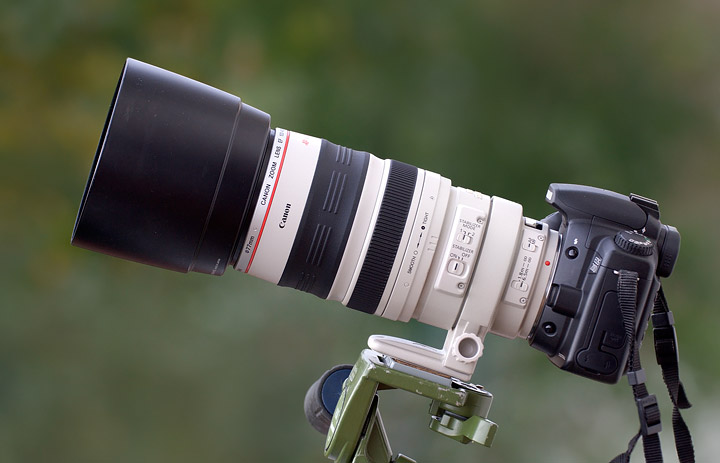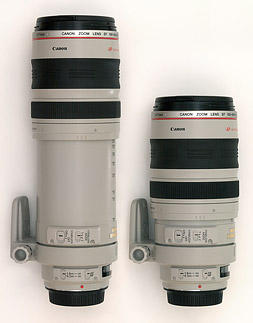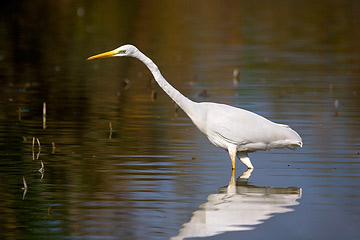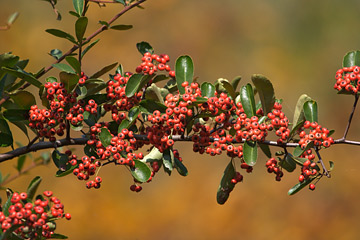Left: the lens fully extended; Right: the lens at its shortest lenght (100mm).
The lens has a 77mm thread for filter or for the large lens hood, made of black plastic. This hood (ET-83C) feels a bit "cheap" and sometimes it is a bit stiff to mount; a metal hood would have been much nicer.
The 100-400 doesn't have a real zoom ring: it has the weird push-pull design. The push-pull allows fast zooming, but I prefer the traditional zoom (al least for a 4x zoom); in some situations it is pretty unconfortable to zoom (for example, when I am in a very tigh place or when I am flat on the ground). Other than that, the manual focus is not as easy as with other lenses, due to the push-pull design. There is a tiny right that allows to control the tightness of the zoom, but it is easy to set it too tight or too smooth. With time you can get used to push-pull, but it would be great to have the "classic" zoom ring.
The lens extends considerably at the longest focal, where it becomes a bit unbalanced, unless you mount it on a gymba-type head. Other than that, the wide excursion and the lack of weather sealing make it more vulnerable to rain and dust.
Next to the zoom, there are the IS switches. This lens had first generation IS, that it not as effective as the latest versions (it "equals" to 2 stops while the latest IS equals to 4 stops). It is necessary to turn off the image stabilizator when you mount the lens on tripod, otherwise the IS unit might act erratically, causing a motion-like blur (this limitation has been eliminate in the subsequent generation of IS). The IS Mode switch allows to select the IS Mode 1 or the IS Mode 2. The Mode 1 correct shake both horizontally and vertically, while Mode 2 acts only vertically: when you use this lens for panning, you have to select mode 2, otherwise the IS will try to compensate your (intended) movements.
Next to the camera there are the AF switches. The autofocus is pretty fast and silent thanks for the Canon USM motor, and it has full time manual focus. There is even a switch to select the focus range between 1.8 meter-infinity and 6.5 meters-infinity; it is not essential, but in some situation is allows to get a faster AF. At the minimum focussing distance, 1.8 meters, this lens gives a pretty good reproduction ratio of 1:5 - the 100-400 works very well even for some large "macro" subjects as butterflies or flowers.
The lens has a detachable tripod collar - even though I often use it handheld for birds and wildlife, I recomment to keep the tripod collar, since it is essential when you use this lens for macro or landscapes.
Similar Lenses (for Canon EOS)
There are many lenses similar to the 100-400, but there is not any real "substitute", even tough the 100-400 is far from perfect.
The
Sigma 80-400 f/4.5-5.6 OS EX has the much nicer "zoom ring" design instead of the push-pull of the Canon, but it has slow non-ultrasonic autofocus, and it has not full time manual focus. It might be a good choice for "macro" and landscapes, but I don't recommend it for wildlife and action.
The
Sigma 50-500 f/4-6.3 EX HSM is an impressive lens, it has a 10x zoom range but the image quality is quite good, even if it is not on par with the Canon, and it is 100mm longer than the 100-400. It has a good HSM autofocus, but it lacks of image stabilization, that is an essential feature on this kind of lenses in my opinion.
The
Canon EF 300mm f/4 L IS USM is sharper, it has IS and fast AF, but it is shorter and it has not the versatility of a zoom. With the 1.4x TC it becomes a 420mm f/5.6 with the same image quality of the 100-400; it is a good choice if you need only the longest focals and you want to photograph small subject (it has a macro ratio of 1:4).
The
Canon EF 400mm f/5.6 L USM is sharper (even with the 1.4x TC it becomes a very sharp 560mm f/8), but it is not very versatile, since it is a prime and it has a ery long minimum focusing distance (3.5 meters), that makes it unsuitable for small subjects. It has a fast AF and I recomment it only if you need the longest and sharpest focal lenght available in this price range.
The
Canon EF 70-200mm f/2.8 L IS USM is not a real alternartive to the 100-400. It is a better lens - sharper, brighter, weather sealed and with the classic zoom ring, but it is much shorter, and it is not great with teleconverters - with the 1.4x is becomes a 90-280 f/4 with an image quality similar to the 100-400, and with the 2x it becomes a 140-400 f/5.6, much softer than the 100-400.
The
Sigma 120-300mm f/2.8 EX HSM is very different lens, more similar to the Canon 300 2.8 L IS than the 100-400. Nevertheless, the price is quite affordable makes it a viable alternative to the 100-400. The Sigma 120-300 is much sharper (even with TCs) and much brighter, but it lacks of image stabilization and it is heavier and bigger than the 100-400. It is a good choice if you plan to use it as "main lens", but I've preferred the 100-400 because I needed a small lens to complement the 600 f4, and the 120-300 is too big to be carried comfortably everywhere.
The
Canon 70-300 f/4.5-5.6 IS USM can be considered the "poor man 100-400". It is much cheaper but it has a similar range and a similar image quality; it has better image stabilization (it used 3rd generation IS while the 100-400 is 1st gen.) and it is much lighter and smaller. On the other hand, it has crappy AF, very average built quality and it is 100mm shorter.
Image Quality
The main concern that I had before buying the 100-400 was the image quality. Even though it is an L series lens, it is not regarded as one of Canon sharpest lenses: it is still acceptable?
From my experience, the answer is surely yes, even though I am not 100% satisfied. The sharpness between 100 and 300mm is very good, even wide open, but at 400mm there is a noticeable drop of sharpness, in particular at 5.6. I don't hesitate to use it at 400 f/5.6 - the detail is still quite good and it is useable even for large prints - but the image quality is clearly not as good as the 400mm 5.6 prime. Other than a slight loss of sharpness, sometimes at 400 5.6 there are some light halos around the areas of strong contrast; they are not nearly as bad as the halos of other lenses as the 70-300 DO, but they are a bit bothering.
The bokeh is good when the background is very distant and out of focus; if the background is not much OOF, sometimes it gives a quite harsh bokeh. At 400mm there is also a little of chromatic aberration, but this is not a problem since it is pretty easy
to eliminate it with Photoshop.
Overall, I think that the image quality of this lens ranges from very good (100-300mm) to acceptable (400mm); it is not bad, but it could be better. The Canon 28-300 L IS USM, a more recent desing, is an 11x zoom and it is as sharp as the 100-400, that is just a 4x zoom: it clearly demonstrates that Canon would be able to desing an updated 100-400 with much better image quality, thanks to the progress of technology.
The following samples show the image quality of the lens at the main focal lengths. The majority of samples are taken at f/4.5 or f/5.6 because I often use this lens wide open for wildlife, and for me it is essential to get good results even at these apertures. These photos are not meant as artistic photos, they are just test samples; if you want to see "artistic" photos taken with this lens browse in the galleries. The photos had been taken in RAW format and converted with Photoshop CS2; I processed them to optimize the image quality (contrast, color, sharpness), and I saved them as high-quality JPEG for web display.
Click on every image to download the full size JPEG sample. Please respect the copyright! These images can be printed only to evaluate the quality of the lens, for personal purposes. All other usages are prohibited.
�
Other Reviews
-
Canon EF 100-400 L IS USM Review by The-Digital-Picture (Bryan Carnathan)
-
Canon EF 100-400 L IS USM vs Canon 70-200 + 2x TC by Luminous Landscape (Michael Reichmann)
-
Canon EF 100-400 L IS USM Review by Matthew K. Whitley
-
Canon EF 100-400 L IS USM Opinion by Birds As Art (Arthur Morris)
-
Canon EF 100-400 L IS USM Review by Digital Outback Photo (Bettina & Uwe Steinmueller)
Conclusions
Pros
. Very versatile zoom range, ideal for wildlife
. It is light and small enough be be carried everywhere, and it is easy to handhold
. Excellent autofocus
. Good image quality between 100 and 300mm
. Minimum focussing distance of just 1.8 and macro ratio of 1:5
Cons
. Slight softness and harsh bokeh at 400mm
. Awkward push-pull design
. Lack of weather sealing
. 1st generation IS (not as effective as the most recent versions, not useable on tripod)
Conclusion
There are many "alternatives" to the 100-400, and for sure it is not the right lens for everyone. If you don't need a lot of reach, and you want the best quality, the 70-200 f/2.8 IS is the best choice. Otherwise, if you don't mind size and weight, the Sigma 120-300 gives much better results and longer reach (it is an excellent 180-420 f/4 with 1.4x and a good 240-600 with the 2x TC). If you don't need the versatility of a zoom, go for the 300 f4 IS or the 400 5.6; on the other hand, if instead you need the maximum versatility, the Canon 28-300 IS or the Sigma 50-500 provides a super-wide 10x zoom range.
I
recommend the 100-400 if you already have a big lens (300 2.8, 500 f4, 600 f4) and you want a much smaller and lighter lens to carry everywhere. The 100-400 is also an excellent choice for handheld photos of birds and wildlife.





 JuzaPhoto contains affiliate links from Amazon and Ebay and JuzaPhoto earn a commission in case of purchase through affiliate links.
JuzaPhoto contains affiliate links from Amazon and Ebay and JuzaPhoto earn a commission in case of purchase through affiliate links.